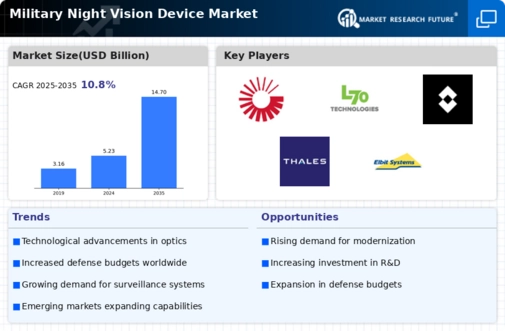Top Industry Leaders in the Military Night Vision Device Market

The Military Night Vision Device Market stands at the forefront of defense technology, playing a crucial role in enhancing situational awareness and operational effectiveness during low-light and night-time operations. This comprehensive overview explores the competitive landscape, incorporating key players, strategies, market share analysis factors, emerging companies, industry news, and investment trends.
Key Players:
- American Technologies Network Corp. (US)
- Collins Aerospace (US)
- Meopta Optica S.R.O (Czech Republic)
- L3 Technologies Inc. (US)
- Harris Corporation (US)
- FLIR Systems Inc. (US)
- BAE Systems plc (UK)
- Bharat Electronics Limited (India)
- Thales Group (France)
- Elbit Systems Ltd. (Israel)
Strategies Adopted:
Key players in the Military Night Vision Device Market employ strategic initiatives to maintain and strengthen their market position. Continuous investment in research and development is a common strategy to introduce innovative night vision technologies, including improved image resolution, extended detection ranges, and enhanced integration with other military systems. Moreover, strategic collaborations with defense agencies, international alliances, and technology providers facilitate the development of tailored solutions, ensuring that night vision devices seamlessly integrate with various military platforms.
Factors for Market Share Analysis:
Market share analysis in the Military Night Vision Device Market is influenced by several critical factors. The performance and reliability of night vision devices, adherence to military specifications, and the ability to provide solutions with increased versatility and adaptability are pivotal. Companies that excel in delivering devices with enhanced durability, reduced size and weight, and compatibility with modern military helmets and weapon systems are likely to secure a significant share of the market. The capacity to address the diverse needs of different military branches and special forces, including ground forces, aviators, and maritime units, is crucial in determining market dominance.
New and Emerging Companies:
In the evolving landscape of the Military Night Vision Device Market, new and emerging companies are making notable strides. Start-ups like Photonis Technologies and Harris Corporation are bringing innovative approaches to night vision technologies, focusing on advancements in image intensification, digital night vision, and integrated sensor solutions. These companies contribute agility and niche expertise to the market, challenging traditional approaches and introducing disruptive technologies that address specific challenges in modern military operations.
Industry News:
Recent industry news underscores the dynamic nature of the Military Night Vision Device Market, with reports of successful device deployments, partnerships between night vision device manufacturers and defense contractors, and advancements in technologies such as fused imaging combining thermal and night vision capabilities. Additionally, news regarding the integration of augmented reality into night vision goggles, the development of ultra-low-light cameras, and the adoption of wireless connectivity features highlight the industry's commitment to staying at the forefront of evolving defense requirements. Such developments contribute to the evolving landscape and indicate a shift towards more advanced and user-friendly night vision solutions.
Current Company Investment Trends:
Investments in the Military Night Vision Device Market reflect a commitment to advancing technology and addressing the evolving needs of modern military operations. Key players are investing significantly in research and development to enhance the capabilities of night vision devices, improve image clarity, and address emerging challenges such as battlefield obscurants. Strategic acquisitions and partnerships to expand solution portfolios, ensure interoperability, and address evolving threats are common investment trends. Furthermore, advancements in digital image processing, artificial intelligence integration, and sustainability initiatives are notable focus areas, aiming to enhance the overall performance and environmental impact of military night vision devices.
Overall Competitive Scenario:
The overall competitive scenario in the Military Night Vision Device Market is characterized by a blend of established players providing comprehensive solutions and innovative newcomers introducing disruptive technologies. As modern warfare scenarios demand enhanced night vision capabilities, the competition revolves around delivering devices that offer improved image quality, extended detection ranges, and increased adaptability to diverse operational environments. The ongoing evolution of military strategies, coupled with the need for lightweight and interoperable solutions, further shapes the competitive dynamics in the market.
Recent Development:
January 2024:
Leonardo DRS (USA): Secured a USD 94 million contract from the US Army for advanced infrared weapon sights for infantry snipers. The Family of Weapon Sights - Sniper, Improved Night/Day Observation Device Block III, aims to provide extended-range target detection, environmental observation, and bullet trajectory tracking.
Thales Group (France): Successfully completed night vision integration testing on its Scorpion reconnaissance helicopter for the French Army. The integration enhances situational awareness and mission effectiveness in low-light conditions.
December 2023:
L3Harris Technologies (USA): Entered a partnership with Merlinhawk Aerospace, an Indian aerospace and defense company, to establish a service center for WESCAM MX-Series electro-optical and infrared (EO/IR) systems. This expands L3Harris's reach in the growing Asian NVD market.
FLIR Systems (USA): Unveiled the Black Hornet 5 NANO, a miniaturized thermal imaging drone designed for close-quarters reconnaissance and situational awareness. This lightweight drone caters to the increasing demand for compact and versatile NVD solutions.


